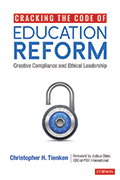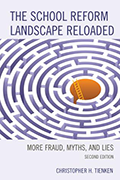Based on the article: Tienken, C.H. (2013). International comparisons of creativity and innovation. Kappa Delta Pi Record, 49, 153-155.
The release of the 2012 results from the Programme for International Student Assessment (PISA) on December 3, 2012, by the Organisation for Economic Co-operation and Development ([OECD], 2013) ushered a cacophony of crisis mongering by education bureaucrats, pundits and neo-liberal policymakers. The sky is always falling.
However, as I have written elsewhere, the weaknesses with the PISA test design, within-country sampling methods, test question design, and score calculations call into question the meaningfulness of the results and rankings, and any inferences made from them about the quality of a country’s education system.
That is not to say that all international education outcome data are meaningless. There exist indices and international student surveys worth data mining. In this entry, I present some rankings and results from international indicators as a basis for starting a different type of discussion—one that rests at the intersection of standardization and creativity. I have presented these ideas previously, as noted in the above citation. The full article cited has more details.
Creativity
Standardizing creativity is an oxymoron. In many ways, creativity can be partly in the eye of the beholder. That is one reason it is difficult to teach creativity aimed at a standard outcome. Likewise, a country cannot standardize itself into producing more creative citizens. Standardized is inherently uncreative.
However, opportunities to engage in experiences and use behaviors and skills that relate to creativity can be offered to students through problem-based, project-based, and activity-based curricula. These types of curricula, by design, require students to develop nonstandard solutions to unstructured problems. Visualize the opposite of the one-size-fits-all monitoring system set up through the Common Core State Standards and national standardized testing and you would be moving your thinking in the right direction.
Indicators of Creativity
There exist multiple indices and indicators of creativity and the output of creative efforts. One indicator is the Global Creativity Index, produced by the Martin Prosperity Institute (2011). So how do countries rank in terms of global creativity? The United States ranked second behind Sweden, and ahead of countries like Finland, Denmark, Australia, Norway, Japan, Germany, and Singapore. China ranked 58th. In economic terms, what can creativity look like? One outgrowth can be entrepreneurship.
Some Downstream Outcomes of Creativity
According to the Global Entrepreneurship and Development Index (Acs & Szerb, 2010), the United States ranked third on the overall Global Entrepreneurship Index, behind Denmark and Canada and ahead of countries like Japan, China, Singapore, and Finland. The United States ranked sixth on the index of Entrepreneurial Attitudes, behind countries such as New Zealand, Canada, Australia, and Sweden. The United States ranked ahead of Finland, Norway, Germany, Japan, and Singapore. China ranked in the lower third of the world. The United States ranked first on the Entrepreneurial Aspirations Index and sixth in the world on turning those aspirations into reality (i.e., Entrepreneurial Activities Index), once again ahead of Japan, Germany, Singapore, and Finland. Denmark was first and China was near the bottom of the world rankings.
Innovation is also one possible outcome of creativity. The Global Innovation Index ranked the United States fifth in the world behind Switzerland, Sweden, United Kingdom, and Netherlands (Dutta & Lanvin, 2013). China ranked 35th. Some outcomes of innovation include utility patents and Nobel Prizes.
According to the U.S. Patent and Trademark Office (2012), the United States was granted 121,026 utility patents in 2012. Utility patents are “issued for the invention of a new and useful process, machine, manufacture, or composition of matter, or a new and useful improvement thereof” (U.S. Patent and Trademark Office, 2013). The 195 countries of the world outside the United States combined for 132,129 utility patents, only 11,103 more than the United States alone; Japan had the second most patents approved in 2012 with 50,677, almost 40% of the rest of the world’s output.
Scientific Creativity
“Scientific creativity” might seem like an odd pairing of words. However, some great scientific discoveries have come about because of creative thinking on the part of the scientist. Though not all scientific endeavors can be labeled creative, scientific output certainly has some relationship to creativity and innovative thinking in many cases.
The number of scientific papers published is a leading indicator of creativity, albeit scientific creativity, and innovation. U.S. scientists, ranking first in the world, published 3,049,662 scientific papers in 2011 (Thomson Reuters, 2011). Chinese scientists published 836,255 papers, and scientists from Germany and Japan published approximately 784,316 and 771,548 papers, respectively.
One hallmark of quality for scientific publications is how many times they are cited. Citations provide an indicator of the level of acceptance of scientific ideas and also of how well those ideas have been vetted and determined to be worth pursuing. Papers from U.S. scientists garnered 48,862,100 citations. The country with the next closest number of citations was Germany with 10,518,133. Papers from Chinese scientists gathered 5,191,358 citations.
Rankings, Rankings, Everywhere
We need to expand our ranking horizons and look at a larger basket of indicators of education quality. If we do so, we might find that the United States already has the system that its policymakers and bureaucrats say they want. All they need to do is open their eyes and their minds.
References
Acs, Z. J., & Szerb, L. (2010, June). The global entrepreneurship and development index (GEDI). Paper presented at the DRUID summer conference, London. Retrieved from http://www2.druid.dk/conferences/viewpaper.php?id=502261&cf=43
Adams, R., Berezner, A., & Jakubowski, M. (2010). Analysis of PISA 2006 preferred items ranking using the percent-correct method. OECD Education Working Papers, No. 46. Paris: Organisation for Economic Co-operation and Development.
Dutta, S., & Lanvin, B. (Eds.). (2013). Global innovation index 2013: The local dynamics of innovation (6th ed.). Geneva, Switzerland: Cornell University, INSEAD, and World Intellectual Property Organization.
Martin Prosperity Institute. (2011). Creativity and prosperity: The 2010 global creativity index. Toronto, ON, CAN: MPI. Retrieved from http://martinprosperity.org/media/GCI Report Sep 2011.pdf
Organisation for Economic Co-operation and Development. (2010). PISA 2009 results: What students know and can do: Student performance in reading, mathematics, and science. Paris: OECD. Retrieved from http://www.oecd.org/pisa/pisaproducts/pisa2009/pisa2009keyfindings.htm
Organisation for Economic Co-operation and Development. (2013). PISA 2012 assessment and analytical framework: Mathematics, reading, science, problem solving and financial literacy. Paris: OECD. Retrieved from http://www.oecd.org/finance/financial-education/oecdpisafinancialliteracyassessment.htm
Sjøberg, S. (2012). PISA: Politics, fundamental problems and intriguing results [English trans.]. La Revue, Recherches en Education, 14, 1–21. Retrieved from http://www.scienceinpublic.com.au/blog/wp-content/uploads/Svein-Sjoberg-PISA-tests_La-Revue_no14-Sept-2012.pdf
Stewart, W. (2013). Is PISA fundamentally flawed? TES magazine, July 31. Retrieved from http://www.tes.co.uk/article.aspx?storycode=6344672
Thomson Reuters. (2011). ScienceWatch: Top 20 countries in all fields, 2001–August 31, 2011. New York: Author. Retrieved from http://archive.sciencewatch.com/dr/cou/2011/11decALL
U.S. Patent and Trademark Office. (2012): Patents by country, state, and year: Utility patents. Alexandria, VA: Author. Retrieved from http://www.uspto.gov/web/offices/ac/ido/oeip/taf/cst_utl.htm
U.S. Patent and Trademark Office. (2013, March). Types of patents. Alexandria, VA: Electronic Information Products Division. Retrieved from http://www.uspto.gov/web/offices/ac/ido/oeip/taf/patdesc.htm


